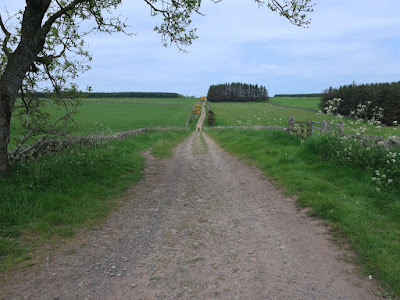Wednesday 31st May 2023
By this point in my holiday I felt like I had been on the Southern Upland Way for many days and yet I still had several more to go, so with the feeling of monotonous repetition I set off again on the trail. I had spent the night in a guest house in Galashiels, so first I had to make my way through the town and back to the point where I had left the Southern Upland Way the day before onto a winding course that took me through the outskirts of Galashiels before climbing around the side of Gala Hill. At the bottom of the hill I came to the River Tweed where I turned left and followed it under Galafoot Bridge and up to a road beside the Gala Water. This road took me to the railway line, where I assume previously the trail used to turn onto the old trackbed, but then in 2015 the line was reinstated so now my path ran alongside the railway, over the River Tweed and into Tweedbank railway station. Originally the line passed all the way through the Scottish Borders to Carlisle, but Tweedbank is currently the terminus so after passing the station I continued along the route of the old railway line before turning back down to the River Tweed which I now followed past Waverley Castle Hotel until I reached Gattonside Suspension Bridge.
For most of this holiday I had been enjoying sunshine everyday but now it was dull and grey, which didn’t help my mood as I was feeling very tired after a poor night’s sleep. I had a rest beside the chain bridge before crossing over the river and back along the other side until I had almost reached Waverley Castle Hotel again. This side of the river was beautifully decorated with wild flowers, which picked up my spirits a little but soon I moved away from the river and onto a track that climbed out of the valley and through dull farmland that matched the dull skies. The undulating path crossed the western slopes above Blake Burn before finally joining a clear track that climbs away from the burn and now provided me with an arrow straight route across tedious landscape. At times the track was lined with gorse, which provided me with some interest, and eventually the sun began to slowly break through the heavy clouds. This track is so straight it is easy to imagine that originally it was a Roman Road and some say it is part of Dere Street which ran from York into Scotland, though its origins may lie elsewhere. The website for the Southern Upland Way gives approximate locations of hidden hoards of treasure along the trail and names one as “Melrose and the Roman Road”, so while on this track I kept my eyes peeled for the sculptured kist that marks the location of the hoard.
Unfortunately I didn’t find it, however I did find an odd object that at the time I didn’t understand but now I think may have been the kist, though I don’t know how you get inside to the coins or why I didn’t realise it was the kist. Perhaps I was so tired I just wasn’t thinking clearly. The one point of interest while on the Roman Road was later when I was diverted around a farm building into woodland with tall, thick grass underneath, but this was very brief and soon I was back on the wide track. Not long after that I started to descend towards the valley of the Lauder Burn, but the path merely skirted the edge of the valley around a golf course before descending into the town of Lauder. There didn’t seem to be much going on in the town so I returned to the trail and entered the grounds of Thirlestane Castle on excellent paths that took me across Lauderdale and up through the woodland. I was feeling very weary by this point in the day and was full of aches and pains as I very slowly dragged myself up the hill and down to the Snawdon Water and then up over a hill that was covered in daisies. Finally, I descended to the Blythe Water where the rambling man website says is the best wild camping spot on the Southern Upland Way and I really needed a good rest after this dreary walk.
This was a delightful spot, especially as it was now sunny and I was able to lie on the short grass beside my tent, bask in the sunshine and recover from the exhausting day. There was nothing in the actual walk that was strenuous but it still seemed to wipe me out. It left me feeling so depressed I had to remind myself that this was not a bad holiday even though the Scottish Borders were not exciting me like the earlier section in Dumfries and Galloway which had provided me with some great walking that made me to want to return. I was finding the Scottish Borders very disappointing, especially on this walk, which was very dull and I was so tired I wasn’t able to ignore that. This was a low point on my holiday. My legs were aching and I had blisters on my feet even though up to this day my boots had performed brilliantly. There is a lot of variety to the Southern Upland Way so with the highs there are some definite lows and this day was my lowest point.








